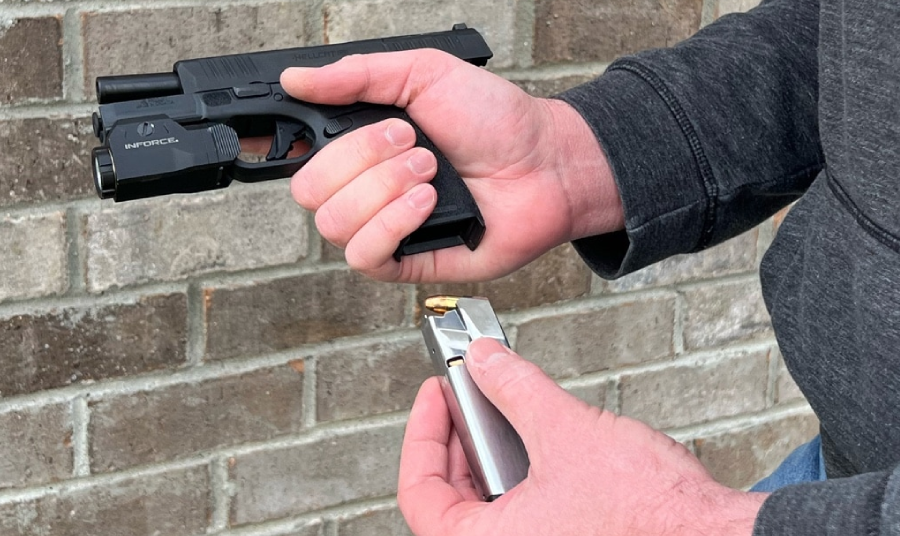Photo credit: Springfield Armory
A tactical flashlight is more than just a tool—it’s a force multiplier in low-light environments. Whether you're a homeowner preparing for a break-in scenario or a professional working night shifts in dangerous terrain, knowing how to use a tactical flashlight for self defense can make the difference between control and chaos.
While these lights provide critical illumination, improper use can expose your position or hinder your effectiveness. Mastery of activation, grip, light discipline, and room-clearing techniques is essential for maximizing the advantages of your light while minimizing the risks.
Momentary vs. Continuous Light: Control the Darkness
One of the core principles in tactical flashlight use is momentary activation. While continuous light may help in navigation or certain controlled scenarios, it can also act as a beacon for anyone looking to shoot back. In a defensive encounter, your goal is visual information without exposure.
Use short, purposeful flashes to illuminate your surroundings and move. This minimizes your visibility while giving you just enough intel to decide your next step. It’s a technique that works especially well in tight home environments where every corner could conceal a threat.
Tactical Flashlight Grip Techniques for Handguns
In handheld configurations, grip matters. Different techniques offer different tradeoffs depending on the situation:
-
Harries Technique: Locks the flashlight against the firearm wrist for stable aim under pressure.
-
FBI Technique: Extends the light away from your body, drawing potential incoming fire off-center.
-
Neck Index: Keeps the light tight under your jawline for quick aiming and rapid reorientation.
Each has its place. What matters is consistent, stress-tested execution. Flashlight grip should complement your firearm handling—not complicate it.
For long guns, pressure pads and thumb-activated tail caps allow weapon-mounted lights to be engaged without breaking your firing grip. These setups are ideal for clearing rooms, covering hallways, or maintaining security in uncertain terrain.
Avoiding Common Mistakes
An unstable grip or poorly placed light leads to a host of problems:
-
Reduced accuracy under recoil
-
Accidental illumination (and position giveaway)
-
Physical fatigue from awkward handling
-
Inconsistent aim due to over-reliance on the light beam
Train your grip as much as your aim. A secure, repeatable position should be second nature long before a real-world incident.
Light Discipline: Flash What You Must, Then Move
Maintaining light discipline is a hallmark of tactical competence. In most cases, leaving the light on continuously isn’t just unwise—it’s dangerous. A smart operator uses:
-
Intermittent pulses
-
Brief strobe bursts
-
Controlled sweeps
High-lumen strobes can disorient an assailant, especially in confined spaces. But use with care—too much exposure, and you may blind yourself or lose track of your surroundings. Flashlights don’t replace situational awareness; they’re tools to support it.
Room Clearing with a Tactical Flashlight
Using a tactical flashlight for room clearing demands more than just lighting up the space. Techniques like “pieing the corner” allow you to gradually reveal threats while minimizing your profile. Keep the beam low and angled—this reduces light splash against walls and preserves your own night vision.
Many shooters also use the light beam itself to approximate aiming in extreme close-quarters situations. While it’s not a substitute for proper sight alignment, the beam can give you a rough target index when split-second decisions matter.
Why Training Trumps Gear
You can have the best tactical flashlight in the world, but without training, it’s just another accessory. Integrate your light into:
-
Movement drills
-
Live-fire practice
-
Home defense walk-throughs
Your goal is to build muscle memory—so when things go loud in the dark, your light becomes an extension of your decision-making, not a complication.
Knowing how to use a tactical flashlight for self defense isn’t about flashing around like a search party. It’s about measured control, fast reactions, and tactical intent. Whether it’s momentary activation, disorienting strobe, or room-clearing precision, your flashlight can give you the edge—but only if you know how to wield it.
Train smart. Move smart. Light smart.
FAQs
1. What is the core principle in tactical flashlight use?
Momentary activation is the core principle in tactical flashlight use.
2. What are some grip techniques for using a tactical flashlight with handguns?
Grip techniques include the Harries Technique, FBI Technique, and Neck Index.
3. What are some common mistakes to avoid when using a tactical flashlight?
Avoid unstable grip, poorly placed light, reduced accuracy, accidental illumination, physical fatigue, and inconsistent aim.
4. How should one maintain light discipline when using a tactical flashlight?
Maintain light discipline by using intermittent pulses, brief strobe bursts, and controlled sweeps.
5. How can high-lumen strobes be used effectively with a tactical flashlight?
High-lumen strobes can disorient an assailant, especially in confined spaces, but should be used with caution to avoid blinding oneself.

